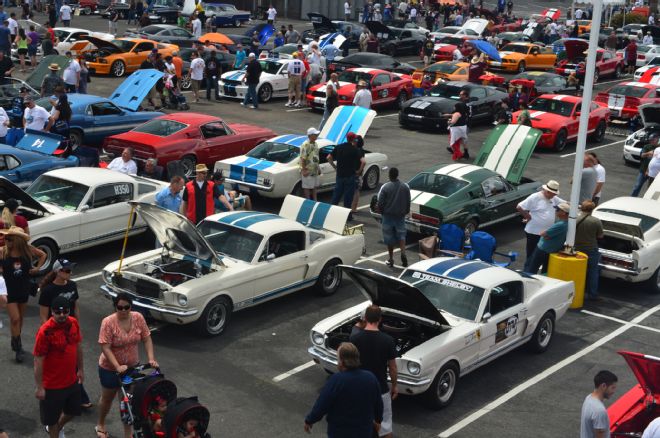
“Shops trick [car] owners into thinking that orange peel is a factory imperfection. The real reason shops knock orange peel is that they need to sand and buff to remove flaws in the paint. Sanding and buffing takes away orange peel and gives shops one last chance to get out little imperfections; such as dirt, a run, a fisheye, or to touch up a chip they made while assembling the car.”
The above quote came from noted Mustang restorer, historian, judge, and Mustang Monthly contributor Bob Perkins, while discussing factory-correct paint on Mustangs. In the MCA world of judging and tallying points, orange peel in paint is not a factory imperfection; orange peel is perfection. A perfect paintjob is one in which the substrate is so well prepared and the paint laid on so uniformly in such a clean environment that spraying produces a uniform peel finish that requires no sanding—same as done by Ford’s Dearborn Assembly plant.
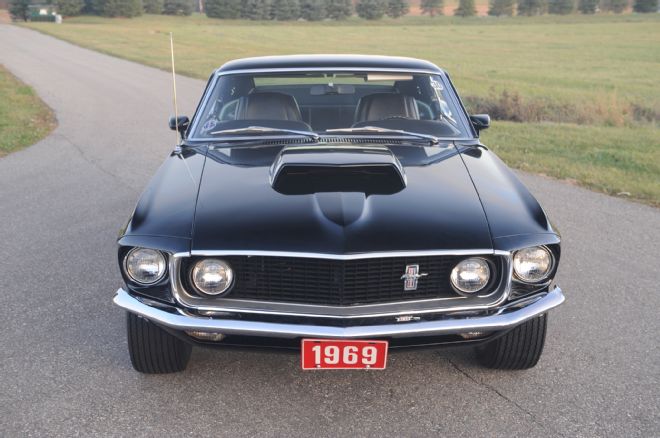 Bob Perkins restored Dave Steine’s 1969 Boss 429 to Thoroughbred status and used single-stage urethane, duplicating the factory procedure with orange peel in the paint. Paint that dries to the rough texture of a real orange peel would look terrible and would result of a problem spraying the car, but the orange peel on a factory paintjob is still very smooth in comparison to an actual orange peel. “Orange peel” is technically a derogatory term for factory finish, but for now we are stuck with it. Some shops claim the factory could not afford the time and expense to buff out a paintjob and this is why the factory leaves orange peel. Then, the shop blesses their own work by claiming they go to the extra expense of sanding and buffing for perfection. The truth is most shops sand and buff to remove imperfections in their paint, which is often desirable with a custom paintjob, but not for a restoration.
Bob Perkins restored Dave Steine’s 1969 Boss 429 to Thoroughbred status and used single-stage urethane, duplicating the factory procedure with orange peel in the paint. Paint that dries to the rough texture of a real orange peel would look terrible and would result of a problem spraying the car, but the orange peel on a factory paintjob is still very smooth in comparison to an actual orange peel. “Orange peel” is technically a derogatory term for factory finish, but for now we are stuck with it. Some shops claim the factory could not afford the time and expense to buff out a paintjob and this is why the factory leaves orange peel. Then, the shop blesses their own work by claiming they go to the extra expense of sanding and buffing for perfection. The truth is most shops sand and buff to remove imperfections in their paint, which is often desirable with a custom paintjob, but not for a restoration.
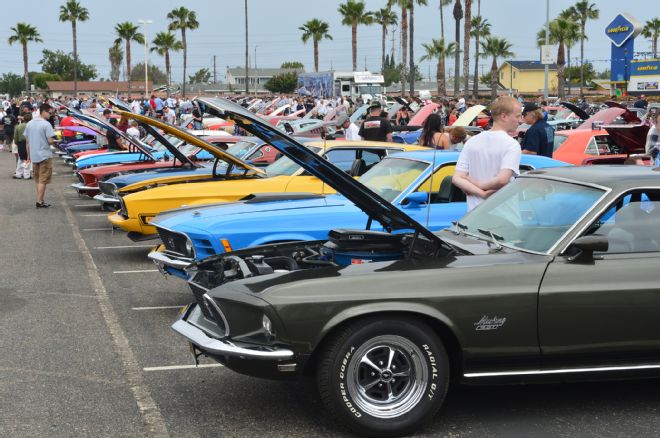 At a typical MCA national show, about 50 percent of restored first-generation Mustangs have “sand and buff” paintjobs, creating a slick surface as opposed to paint with a factory orange peel appearance. Why is this? A factory-style repaint with orange peel demands the substrate be almost perfectly prepared and the primer and paint sprayed in a pristine environment. Debris in the topcoat requires sanding and buffing to eliminate the trash. Sanding and buffing destroys orange peel, and herein lays the rub (pun intended).
At a typical MCA national show, about 50 percent of restored first-generation Mustangs have “sand and buff” paintjobs, creating a slick surface as opposed to paint with a factory orange peel appearance. Why is this? A factory-style repaint with orange peel demands the substrate be almost perfectly prepared and the primer and paint sprayed in a pristine environment. Debris in the topcoat requires sanding and buffing to eliminate the trash. Sanding and buffing destroys orange peel, and herein lays the rub (pun intended).
 Shelby American and AO Smith painted fiberglass body panels, such as a hoods and decklids with lacquer, which they lightly sanded and buffed because they did not have the advanced paint booths and drying capabilities of Ford assembly plants. Today, some collectors blame the color mismatch between fiberglass and metal panels of 1965 to 1970 Shelby Mustangs on the two different paints: acrylic enamel on metal and lacquer on fiberglass. Perkins believes the color match was very close when the cars were new, but over time the lacquer faded more than the acrylic enamel for a bigger color mismatch.
Shelby American and AO Smith painted fiberglass body panels, such as a hoods and decklids with lacquer, which they lightly sanded and buffed because they did not have the advanced paint booths and drying capabilities of Ford assembly plants. Today, some collectors blame the color mismatch between fiberglass and metal panels of 1965 to 1970 Shelby Mustangs on the two different paints: acrylic enamel on metal and lacquer on fiberglass. Perkins believes the color match was very close when the cars were new, but over time the lacquer faded more than the acrylic enamel for a bigger color mismatch.
New car manufacturers start with brand-new metal and their paint rooms are pristine and near surgically clean, so the paint is applied in perfect conditions. Even so, most new car finishes dry with a slight bit of orange peel. Orange peel is the result of how the painter applied the paint and the environment in which the paint dried, and while it’s factory-correct (even among high-end cars like Porsches and Ferraris), it does tend to diminish some of the shine in the paint. In the case of a high-end custom paintjob, the process of color sanding and buffing with compound is done to eliminate all traces of orange peel, and create a mile-deep, super-smooth paintjob. But that is very time-consuming and therefore expensive, even for the luxury and high-end automakers, and as Perkins points out, if you’re looking for originality the lack of orange peel is a sign that the car has been repainted and therefore does not have original paint.
Perkins feels that color sanding and buffing, when done to a factory restoration effort, is a sign of a lazy painter, and/or one with less-than-perfect painting conditions. He elaborated, saying “See, the thing is, if you get a piece of debris floating in the paint, maybe an eyelash or a dirt particle or even a mosquito, and you’re not sanding and buffing, you’ve got to sand the entire panel and paint over again if you’re going to leave orange peel. But, if you don’t have to worry about orange peel, you can just bury a damn mosquito in there and sand and buff and nobody will know an insect is embedded in your paintjob. That’s why I say if you don’t worry about orange peel, you can paint cars in a backyard or in a cornfield; put a respirator on my 12 year-old and he can do it.”
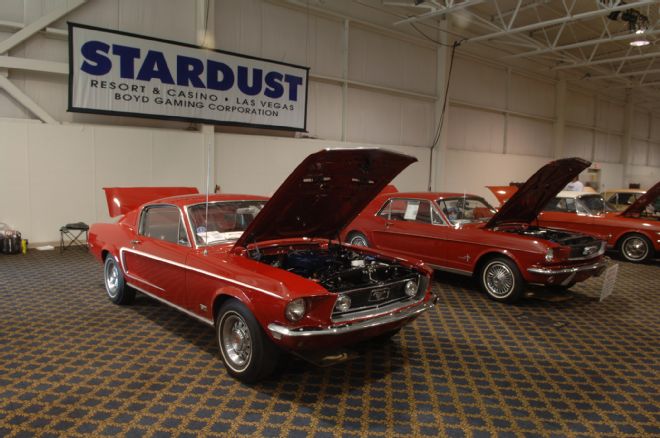 According to Perkins, “In the ’60s, there was absolutely no paint on an American-made car that was as durable as Ford’s acrylic enamel. Just look at Corvettes. Have you ever seen a Corvette from the ’60s with original paint? They aren’t worth a hoot for two reasons. They were fiberglass and they were done in lacquer. Lacquer is not as durable as acrylic enamel. But, even with GTOs and other metal GM cars, it is rare to find one where the lacquer has held up like Ford’s acrylic enamel.”
According to Perkins, “In the ’60s, there was absolutely no paint on an American-made car that was as durable as Ford’s acrylic enamel. Just look at Corvettes. Have you ever seen a Corvette from the ’60s with original paint? They aren’t worth a hoot for two reasons. They were fiberglass and they were done in lacquer. Lacquer is not as durable as acrylic enamel. But, even with GTOs and other metal GM cars, it is rare to find one where the lacquer has held up like Ford’s acrylic enamel.”
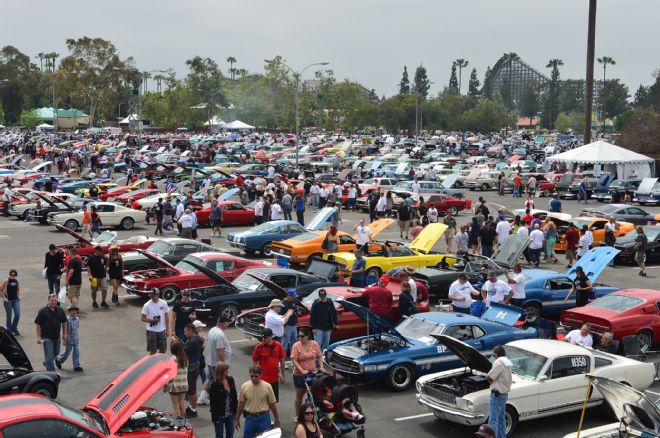 Lack of orange peel is a mandatory three-point deduction in concours classes in Mustang Club of America judging. Three points is not much for a 700-point judging system, but in Thoroughbred class, on the basis of workmanship judges may deduct points for inconsistency with respect to sanding and buffing. For example, they buff the roof, but don’t buff the underside of the hood or the lower quarter-panels.
Lack of orange peel is a mandatory three-point deduction in concours classes in Mustang Club of America judging. Three points is not much for a 700-point judging system, but in Thoroughbred class, on the basis of workmanship judges may deduct points for inconsistency with respect to sanding and buffing. For example, they buff the roof, but don’t buff the underside of the hood or the lower quarter-panels.
Perkins gets carried away with metaphors about painting because of what he calls The Great Orange Peel Deception. New Mustangs, F-150 pickups, Lincolns, and Fusions have orange peel, same as almost every new car, including the exotics. The presence of sanding and buffing on a new car is a red flag of a repaint, say from a damaged panel.
Perkins gave us an example of a 2002 Dodge Viper he bought new. “When I got my Viper home, I saw rubbing compound under the hood. Man, I was sick. I quickly drove into Milwaukee to look at a Viper in a Dodge showroom. I found out that Viper panels were painted in different parts of the factory. They did not have a typical factory paint system to give a clean, perfect type of paintjob. That’s why they were sanded and buffed. I’ve disliked the paint on that car ever since.”
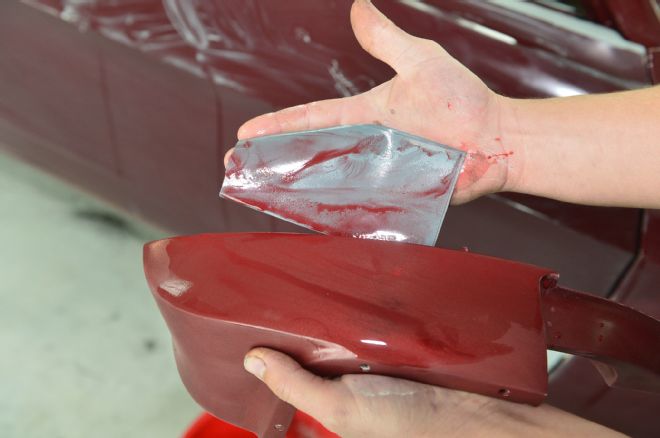 How does a show judge convince an argumentative owner that his car is clear coated? The judge asks the owner to rub the paint with a little fine compound. If the rag shows paint color, then the paint has not been clearcoated.
How does a show judge convince an argumentative owner that his car is clear coated? The judge asks the owner to rub the paint with a little fine compound. If the rag shows paint color, then the paint has not been clearcoated.
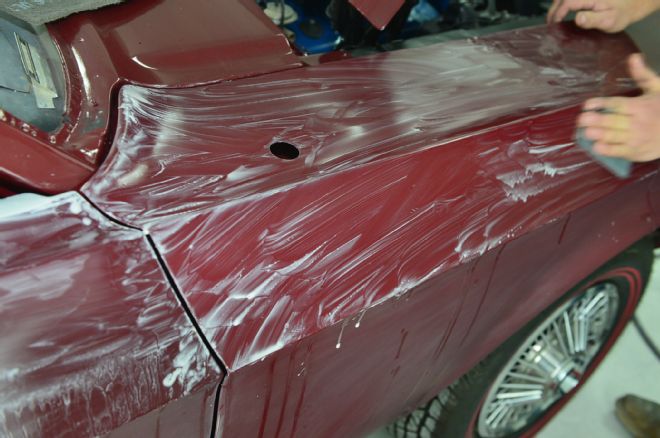 When compounding the paint shows gray, the paint has been clearcoated.
When compounding the paint shows gray, the paint has been clearcoated.
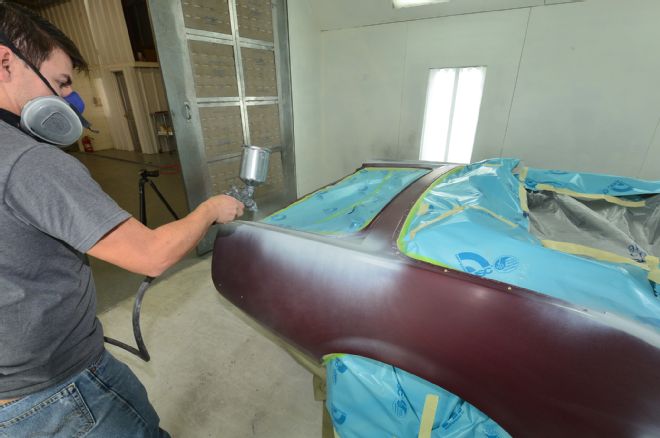 Even base coat/clearcoat dries to an orange peel. If you don’t want the orange peel finish, color sanding and buffing will remove it.
Even base coat/clearcoat dries to an orange peel. If you don’t want the orange peel finish, color sanding and buffing will remove it.
For a better understanding of orange peel, consider a first-generation Mustang factory paint job, sprayed in an ultra-clean room and baked on the body. The acrylic enamel is sprayed on with a slight orange peel texture, and when baked shrinks the paint even more, creating what Perkins calls “orange peel within an orange peel.” Perkins made the process ultra-simple with a good example, “If you dump a gallon of acrylic enamel on top of a flat piece of sheetmetal, it’s going to flow out until it is perfectly level and as slick as it could possibly be. You run it through the oven and bake the paint to dry and you will have orange peel.”
Today’s typical re-paint does not happen under factory conditions. After spraying, a painter lets the paint dry then sands out the imperfections—the dirt and garbage. This sanding removes the orange peel, along with the dirt and debris. Perkins feels that painters must do this sanding to cover up flaws in their paint. However, factories have much better facilities. Factory paint on first-generation Mustangs is about 3- to 3 1/2-mils (1/1000 of an inch) thick. In contrast, a typical repaint job is three to four times as thick, or 8-12 mils. Thicker paint gives more of an opportunity to shrink and create a failure, such as checking.
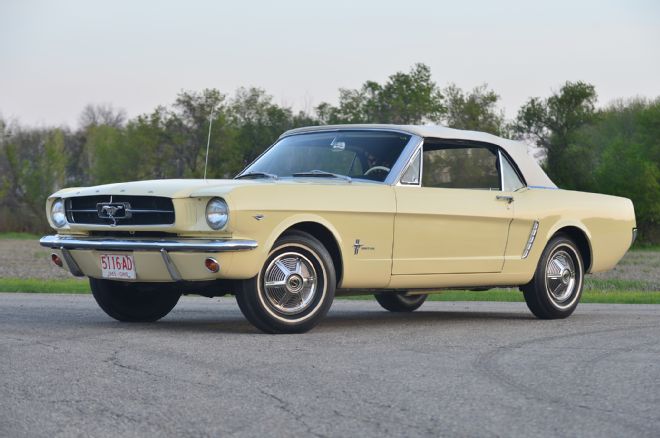
Perkins said, “You never, ever see original paint on a Mustang from 1965-1973 with cracked or checked paint. Ford paint never cracks. It just doesn’t happen. If you see a little weather checking or cracking on an original paint Ford car, then the paint has been spotted (touched up).”
Perkins referenced a Mustang owned by Bob Winaircyck in Atlanta, Georgia as an example of perfection. “He has a Lime Gold Boss 302, which is not a very flashy color. That car has the most beautiful factory looking paintjob I have seen in 30 years of Mustang shows. And you know who painted it? Sam Murphy, who painted for 25 years at the Ford assembly plant in Atlanta. He even affixed his "PAINT OK MURPHY" stamp he used at Ford. But, there are just not many people around who can do it or will take the time or have the environment to do it.”
The choice of factory orange peel or slick paint is up to the individual. However, the fact is orange peel is not a factory imperfection when it comes to an original finish—it’s just the way it is. Yet, this line of thinking continues to circulate, courtesy of the Great Orange Peel Deception.
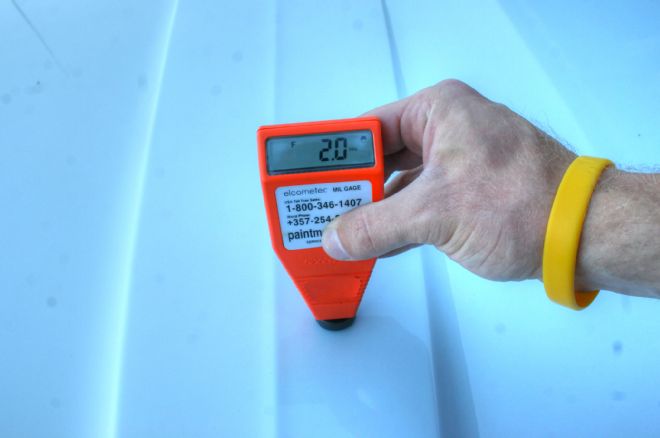 The durability of ’60s Mustangs with original factory acrylic enamel paint is due to the 3- to 3 1/2-mils thickness of the paint. Thinner paint is more durable than thicker paint. Perkins believes baked acrylic enamel is the most durable paint Ford ever used. An Elcometer measures mil thickness of paint to remove all doubt on cars reported to have original paint. Most car clubs, including the Mustang Club of America, do not allow the use of Elcometer in judging. They are very handy when inspecting a car for purchase, especially for people not trained in paint and body. Paint meters gauge thickness scientifically. The paint on this original paint 1970 Mustang is only 2 mils. The orange peel is still visible.
The durability of ’60s Mustangs with original factory acrylic enamel paint is due to the 3- to 3 1/2-mils thickness of the paint. Thinner paint is more durable than thicker paint. Perkins believes baked acrylic enamel is the most durable paint Ford ever used. An Elcometer measures mil thickness of paint to remove all doubt on cars reported to have original paint. Most car clubs, including the Mustang Club of America, do not allow the use of Elcometer in judging. They are very handy when inspecting a car for purchase, especially for people not trained in paint and body. Paint meters gauge thickness scientifically. The paint on this original paint 1970 Mustang is only 2 mils. The orange peel is still visible.
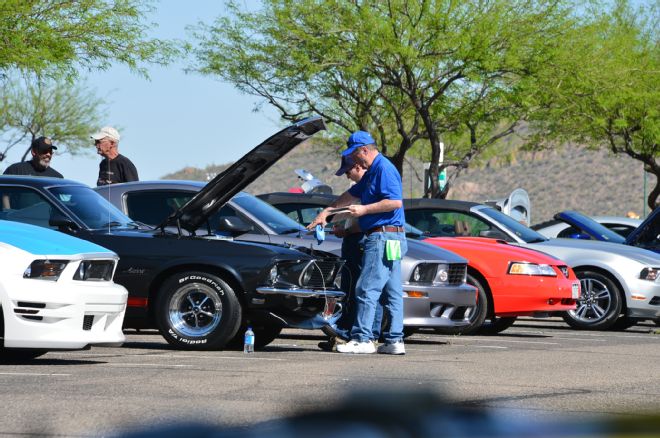 “I got a better paintjob than factory,” is a common statement at car shows. Bob Perkins answers these people, “If it was better than factory why do most collectors want original paint?” He thinks the best compliment a painter can receive is when a judge looks a little confused when he asks if the car has original paint. Judges can spot most repaints 20 feet from the car due to sanding and buffing.
“I got a better paintjob than factory,” is a common statement at car shows. Bob Perkins answers these people, “If it was better than factory why do most collectors want original paint?” He thinks the best compliment a painter can receive is when a judge looks a little confused when he asks if the car has original paint. Judges can spot most repaints 20 feet from the car due to sanding and buffing.